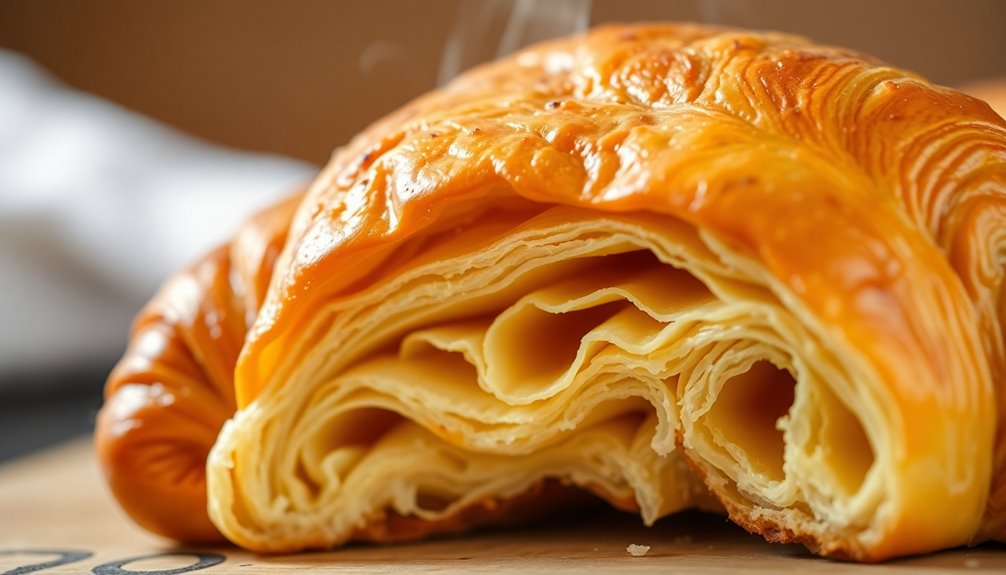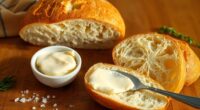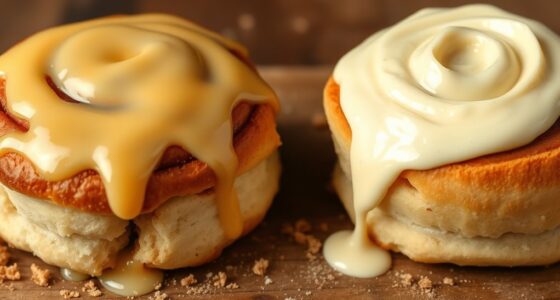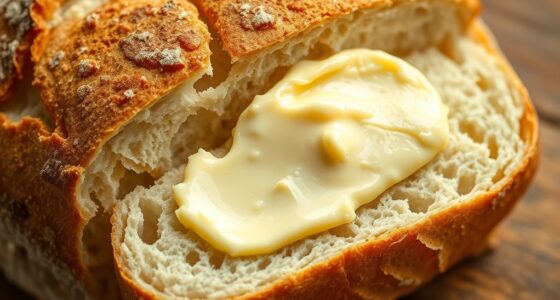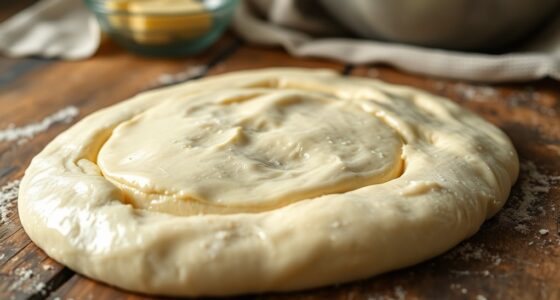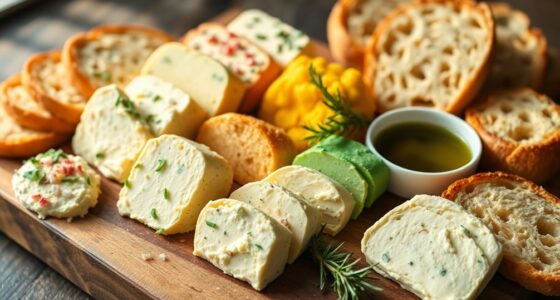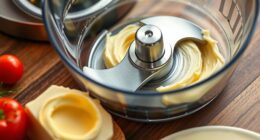To achieve pastry perfection, you need to understand the science of flaky layers. Start with high-quality, low-protein flour and plenty of cold, unsalted butter—aim for a fat-to-flour ratio of at least 1:1. Use the lamination technique to create distinct layers by rolling and folding the dough. Keep everything cool to prevent melting, and don't overhandle your pastry. Master these methods, and you'll be creating delicious, buttery layers in no time. Discover even more tips to elevate your baking!
Key Takeaways
- Flaky pastry achieves its texture through layers of cold butter, which creates distinct, airy flakes when rolled and folded properly.
- A high fat-to-flour ratio (at least 1:1) is crucial for tenderness and rich flavor in flaky pastry.
- Proper lamination techniques, including chilling dough between folds, ensure even fat distribution and maintain the integrity of flaky layers.
- Using high-quality, low-protein flour minimizes gluten formation, contributing to the delicate texture of flaky pastry.
- Adding an acid like vinegar or lemon juice enhances the tenderness and overall quality of the pastry.
Understanding Flaky Pastry
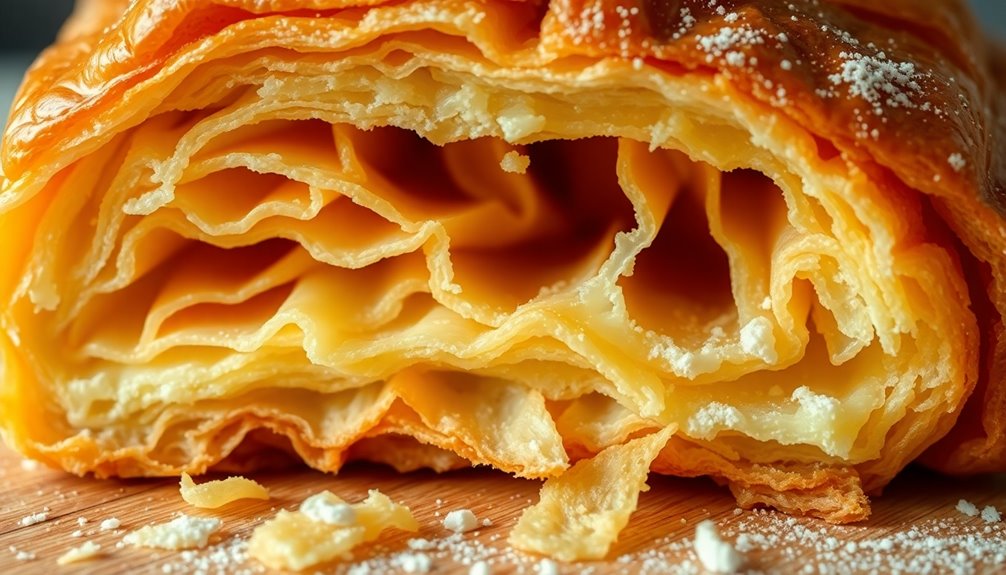
Flaky pastry is a delightful creation in the world of baking, known for its light and airy texture. By understanding the ingredients, you can achieve that sought-after flaky texture.
The secret lies in incorporating large lumps of butter into the dough, creating distinct layers of fat. When you roll and fold the dough, you're not just mixing; you're building those unique flakes that puff up beautifully when baked.
Unlike puff pastry, which has uniform layers, flaky pastry showcases separate layers, enhancing its charm. This versatility allows you to use it in various dishes, from pasties to sausage rolls.
Plus, its quick preparation method means you can whip it up without hours of effort, making it a go-to for busy bakers.
Key Ingredients for Success
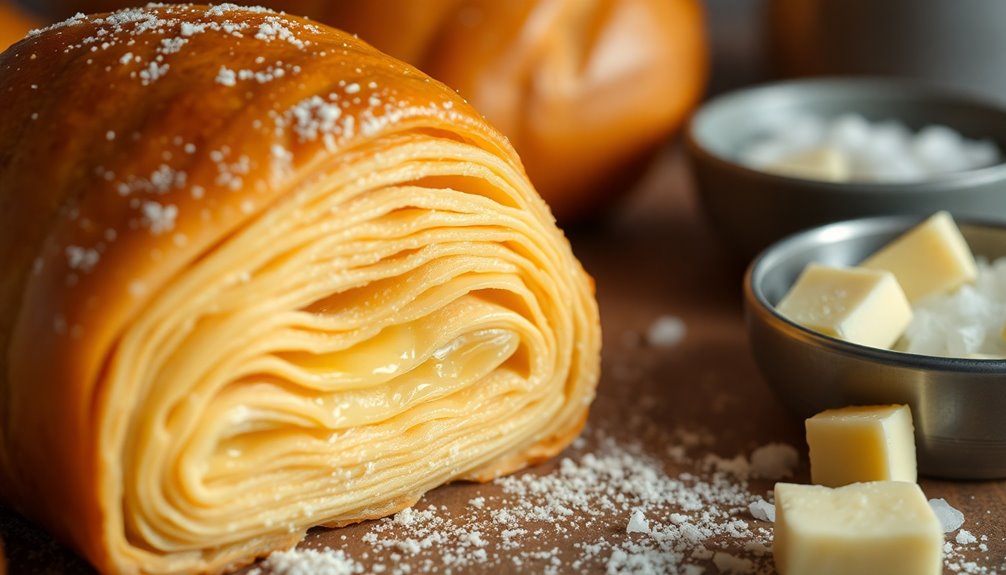
To achieve perfect flaky pastry, you need to focus on the key ingredients that make all the difference.
Start with high-quality flour, ideally a low-protein variety like pastry flour, to minimize gluten formation. This helps prevent toughness and allows for those delicate layers you crave.
Next, incorporate a significant amount of fat—aim for at least half the weight of the flour. This fat, usually butter, creates steam during baking, contributing to that vital flaky texture.
Don't forget water; it's essential for gluten development, but use it sparingly to avoid sticky dough.
Finally, consider adding an acid like vinegar or lemon juice to further inhibit gluten formation and enhance tenderness.
These ingredients work together to create pastry perfection.
The Importance of Butter
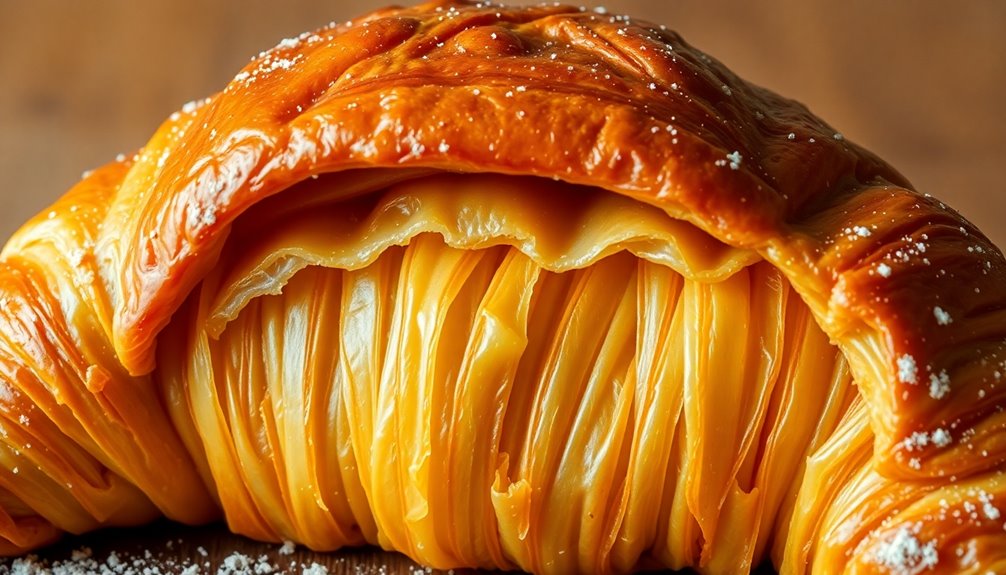
When it comes to achieving that coveted pastry perfection, butter plays an indispensable role.
It's the secret behind those light, flaky layers you crave. When melted, butter creates steam that expands and separates the dough, enhancing the flakiness of your pastry.
To get the best results, consider these tips:
- Use high-fat butter (around 80% fat content) for better lamination and moisture.
- Keep your butter cold to maintain distinct layers.
- Aim for unsalted, high-quality butter to maximize flavor.
- Remember, the fat content should be at least half the weight of the flour.
Incorporating these elements guarantees your flaky pastry is rich, buttery, and utterly delightful. Additionally, using high-fat butter not only improves texture but also contributes essential fat-soluble vitamins A, D, and E, enhancing the nutritional profile of your pastries.
The Role of Gluten Development
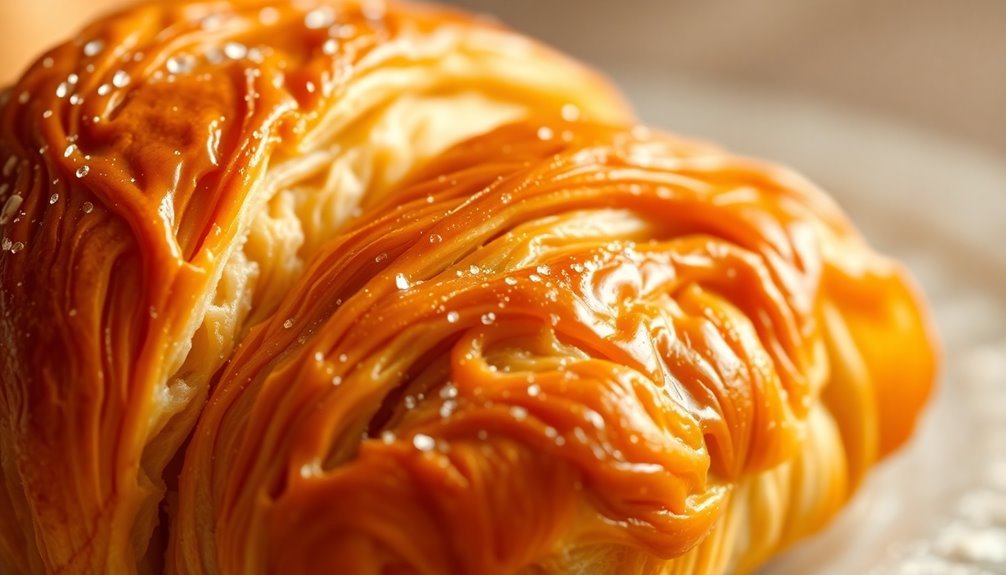
When you mix flour with liquid, gluten forms a stretchy network that's essential for your pastry's structure.
Proper hydration activates these proteins, allowing them to bond and create the right texture.
However, be careful not to over-mix, as too much gluten can lead to tough pastries instead of the tender, flaky ones you want.
Gluten Structure Formation
Understanding gluten structure formation is essential for mastering pastry making, as it directly influences the texture and integrity of your baked goods. When you mix flour with liquid, gluten proteins create an elastic network vital for structure.
To achieve those coveted flaky layers, consider these key points:
- Use low-protein flours like cake or pastry flour to minimize gluten formation.
- Balance hydration carefully; too much water toughens pastry, while too little leads to crumbling.
- Incorporate an acid, such as vinegar or lemon juice, to inhibit gluten development for a tender result.
- Employ proper mixing techniques and let the dough rest to control gluten formation, ensuring your pastry is light and flaky.
Hydration and Bonding
Achieving the right hydration level is essential to mastering gluten development in pastry. When you mix flour with liquid, glutenin and gliadin proteins hydrate and bond, forming the structure necessary for your dough.
The degree of hydration greatly influences gluten formation; too much water can create a tough texture, while ideal hydration results in a tender, flaky pastry. To minimize gluten development, use low-protein flours like pastry or cake flour.
Impact on Texture
While you mightn't think about it, the development of gluten in your pastry dough greatly impacts its final texture.
Proper gluten management is essential for achieving those delightful flaky layers you crave.
- Too much gluten can lead to a tough, chewy texture.
- Low-protein flours, like pastry flour, are ideal for flaky pastries.
- The right balance of hydration prevents excess gluten formation.
- Adding an acid, like vinegar or lemon juice, helps keep the pastry tender.
Additionally, understanding diversification strategy can enhance your approach to various types of pastry recipes, allowing you to experiment with different flavors and textures.
Mastering the Lamination Technique
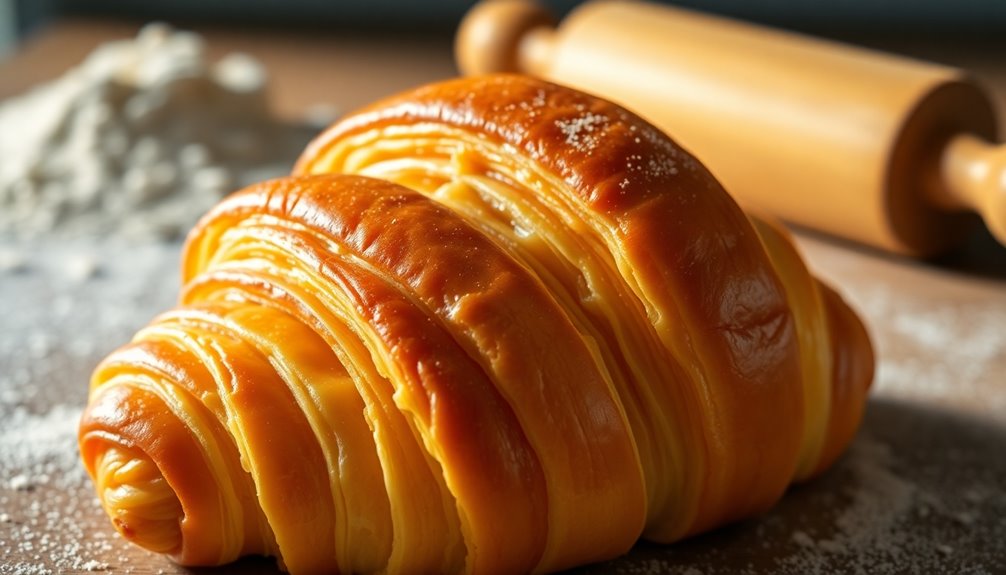
Lamination is the secret behind those irresistibly flaky pastries you crave. This technique involves rolling dough into a thin sheet and encasing high-fat butter, creating alternating layers of dough and fat used to achieve that coveted texture.
Each fold multiplies the layers exponentially; three book folds can yield up to 64 layers! It's essential to chill the dough between folds to keep the fat solid, ensuring distinct layers during baking.
Mastering proper folding techniques, like the book or letter fold, helps maintain an even distribution of fat, giving your pastries their signature rise.
Tips for Achieving Perfect Layers
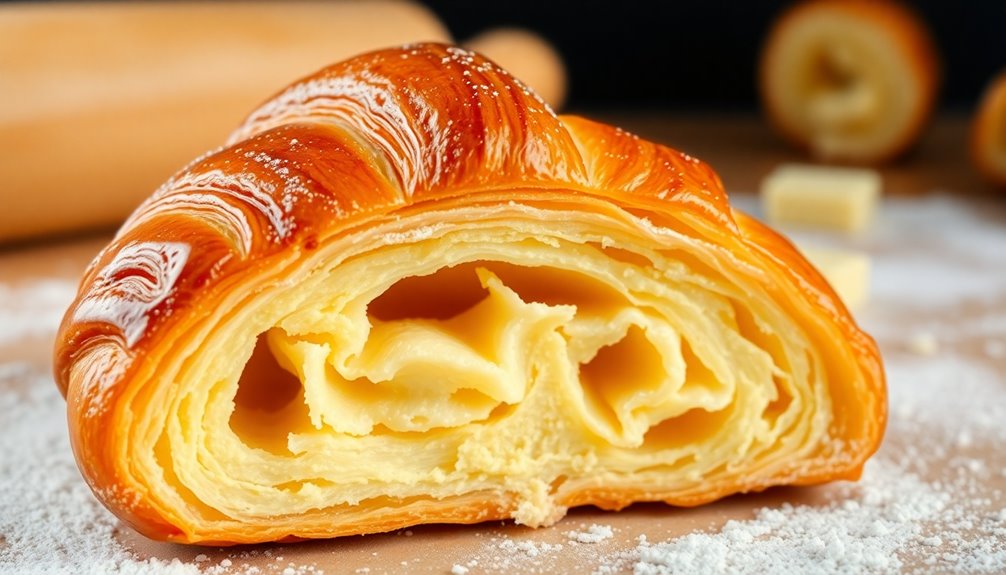
Once you've mastered the lamination technique, focusing on achieving perfect layers is key to elevating your pastry game.
Here are some tips to help you create those flaky, buttery layers:
- Use high-fat butter (at least 80% fat content) for distinct layers.
- Incorporate large chunks of fat into the dough to enhance separation.
- Chill the dough between folds to maintain the integrity of the layers.
- Monitor the baking temperature closely; a high initial heat (around 200°C or 400°F) helps lift the layers.
Baking Techniques for Flaky Pastry
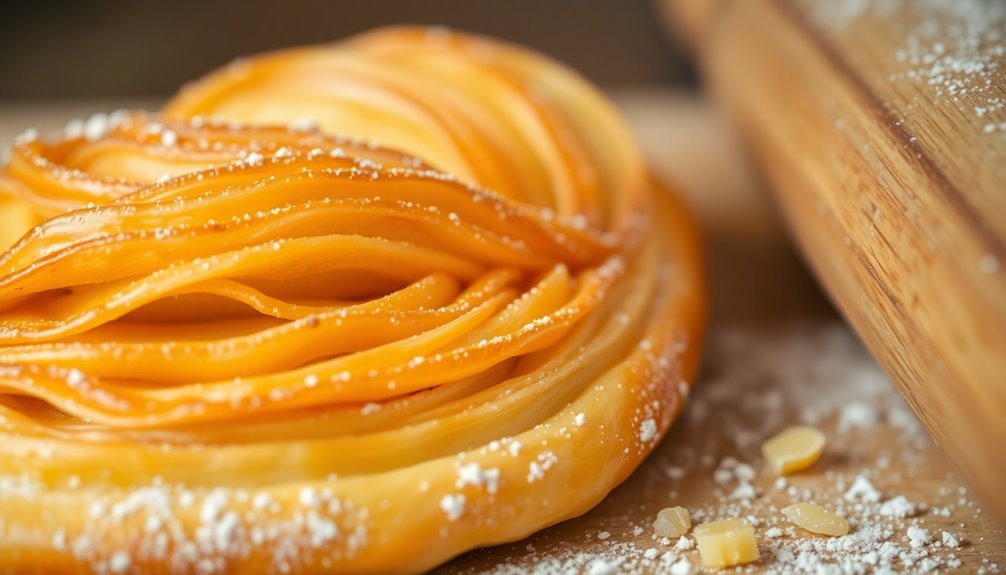
When you're aiming for that perfect flaky pastry, mastering layering techniques is key.
You'll want to focus on how fat is incorporated into your dough to achieve those distinct layers.
Understanding these elements will set you on the path to pastry perfection. Butter making devices can also enhance the quality of your pastry by ensuring consistent fat incorporation.
Layering Techniques Explained
To achieve that perfect flaky pastry, mastering layering techniques is essential. The lamination technique involves rolling and folding your dough multiple times, creating alternating layers of fat and dough. This process is crucial for achieving a flaky texture.
Here are some tips to help you perfect your layering:
- Chill the dough between folds to keep the fat solid.
- Use book folds to exponentially increase layers—three folds can yield up to 64 layers!
- Preheat your oven for quick fat melting, generating steam that lifts those layers.
- Monitor baking time closely to avoid dry or soggy results.
Importance of Fat
Fat plays a pivotal role in creating flaky pastry that delights the palate. The choice of fat, whether high-fat butter, shortening, or lard, greatly affects the moisture and distinct layers you'll achieve during baking.
Butter, with its 80% fat content, generates steam that expands and puffs the layers, giving you that light, flaky texture. To maintain those essential layers, keep your fat solid while preparing the dough; incorporating cold fat is key for peak flakiness.
Aim for a fat-to-flour ratio of at least 1:1 to guarantee richness and structural integrity. Techniques like lamination help distribute fat properly, keeping the layers distinct and contributing to the airy texture you desire in your final baked product. Additionally, using high-fat butter can enhance the flavor profile and richness of your pastry.
Storage and Handling of Pastry
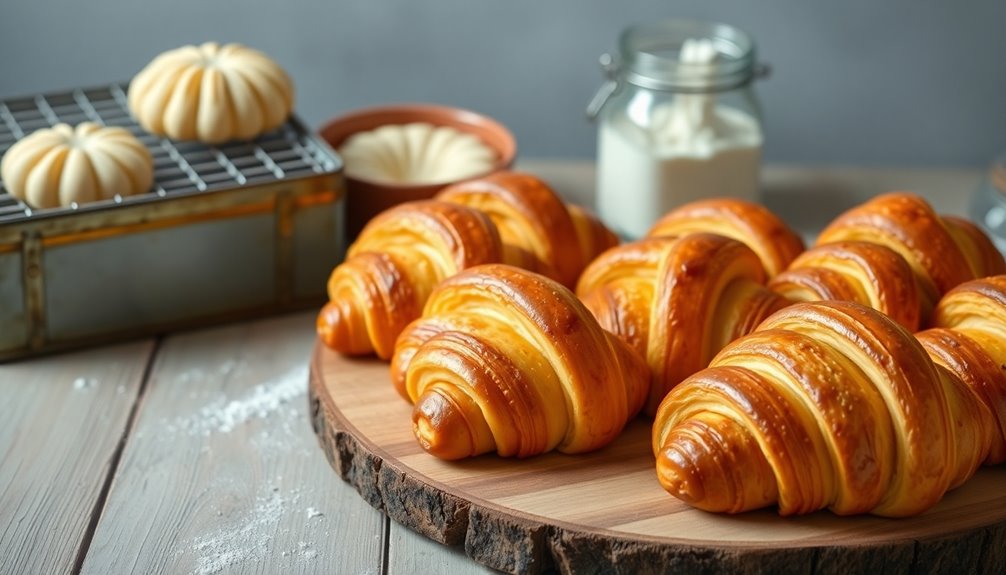
Proper storage and handling of flaky pastry is essential to maintain its delightful texture and flavor.
To guarantee your pastry stays fresh, follow these tips:
- Wrap it tightly in plastic wrap or use an airtight container for storage.
- Freeze freshly made pastry for several weeks to keep those layers intact.
- Store baked pastries in a cool, dry place and avoid covering them while they cool.
- Work quickly and keep your ingredients cool to prevent the fat from melting during handling.
Creative Applications for Flaky Pastry
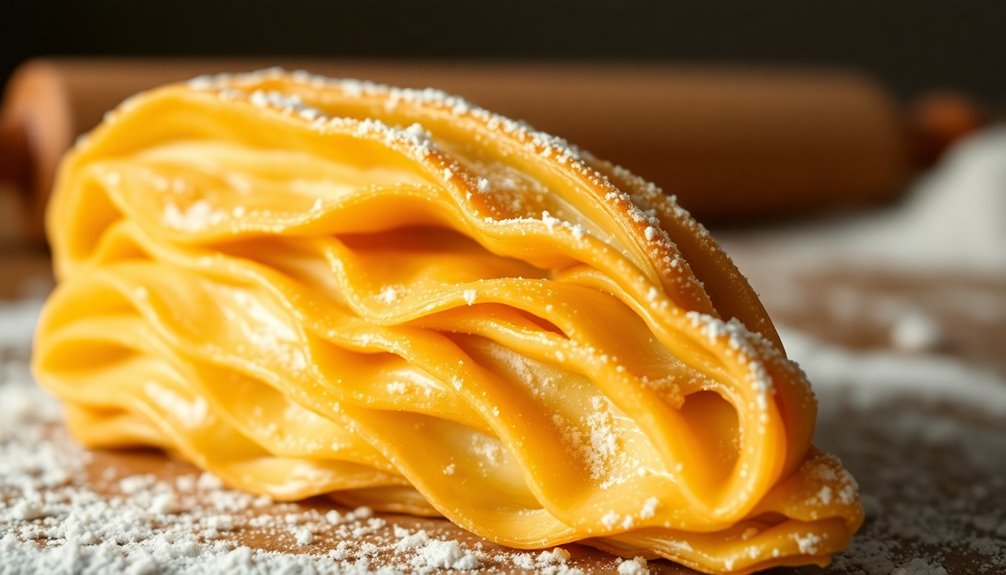
While flaky pastry is often celebrated for its delicate layers, its versatility truly shines in the kitchen. You can whip up an array of savory and sweet dishes, like pasties, turnovers, and sausage rolls, showcasing the creative applications for flaky pastry.
The distinct texture holds fillings perfectly, making it ideal for elegant fruit tarts without sogginess. You can even adapt it for traditional favorites like samosas, adding your own twist.
With its large chunks of butter, flaky pastry creates those irresistible layers that make every bite delightful. Shape it into plaits or braids for an eye-catching presentation, enhancing the overall appeal of your baked goods.
The possibilities are endless when you get creative with this versatile pastry!
Frequently Asked Questions
What Is the Science Behind Flaky Layers in Puff Pastry?
The science behind flaky layers in puff pastry lies in the lamination process. You roll and fold dough with layers of cold butter, creating multiple distinct layers.
When baked, the moisture in the butter turns to steam, lifting the layers apart. Using low-protein flour helps keep the pastry tender by limiting gluten development.
Chilling the dough between folds guarantees the fat stays solid, which is vital for achieving that perfect flaky texture you crave.
What Is the Science Behind Flaky Pie Crust?
To create a flaky pie crust, you need to use cold butter or fat in large chunks. This keeps the flour from fully merging, forming distinct layers.
You should also pay attention to hydration; adding just the right amount of water activates gluten while keeping the dough tender.
Rolling and folding the dough traps steam, and baking at a high temperature helps expand those layers, giving you that perfect flakiness.
Why Does Butter Make Pastry Flaky?
Butter makes pastry flaky because it creates steam as it bakes, helping to separate layers of dough.
Its high-fat content coats flour particles, preventing too much gluten from forming, which keeps your pastry tender.
When you use cold butter and fold it into the dough, it forms distinct layers that puff up as the fat melts.
This process, combined with evaporating water, gives your pastry that light, airy texture you love.
How Is a Crispy Texture With Flaky Layers Achieved in Flaky Pastry?
To achieve a crispy texture with flaky layers in pastry, you'll need to incorporate cold butter into your dough in large lumps. This creates distinct layers that form when the butter melts and produces steam during baking.
Using low-protein flour minimizes gluten development, keeping the pastry tender.
Remember to chill the dough between folds and bake at a high temperature initially, allowing the steam to expand and create that perfect flakiness.
Conclusion
In the world of pastry, achieving flaky, buttery layers isn't just an art; it's a science. Did you know that a well-executed lamination can create up to 1,000 layers in a single pastry? By mastering key techniques and understanding your ingredients, you're set to elevate your baking game. So, roll up your sleeves, embrace the process, and enjoy the delicious rewards of your flaky creations. With practice, you'll be crafting pastry perfection in no time!
